University Report: Understanding and Supporting Inclusion, EDU30005
VerifiedAdded on 2023/03/17
|9
|2297
|93
Report
AI Summary
This report delves into the complexities of Joubert Syndrome (JS), a neurodevelopmental disorder, and its implications for education. It examines the clinical attributes of JS, including motor, language, and visual challenges, and emphasizes the importance of inclusive practices. The report explores relevant policies like the Melbourne Declaration and the Disability Discrimination Act (DDA 1992) in Australia, highlighting their roles in supporting children with JS. It emphasizes the need for curriculum modifications, individualized support, and the establishment of inclusive learning environments. Recommendations include curriculum developers considering children's strengths, implementing varied learning activities, and fostering partnerships between educators, families, and professionals. The report underscores the significance of understanding JS to create effective interactions and learning environments, ensuring that children with JS have equal opportunities to learn and participate in daily routines.
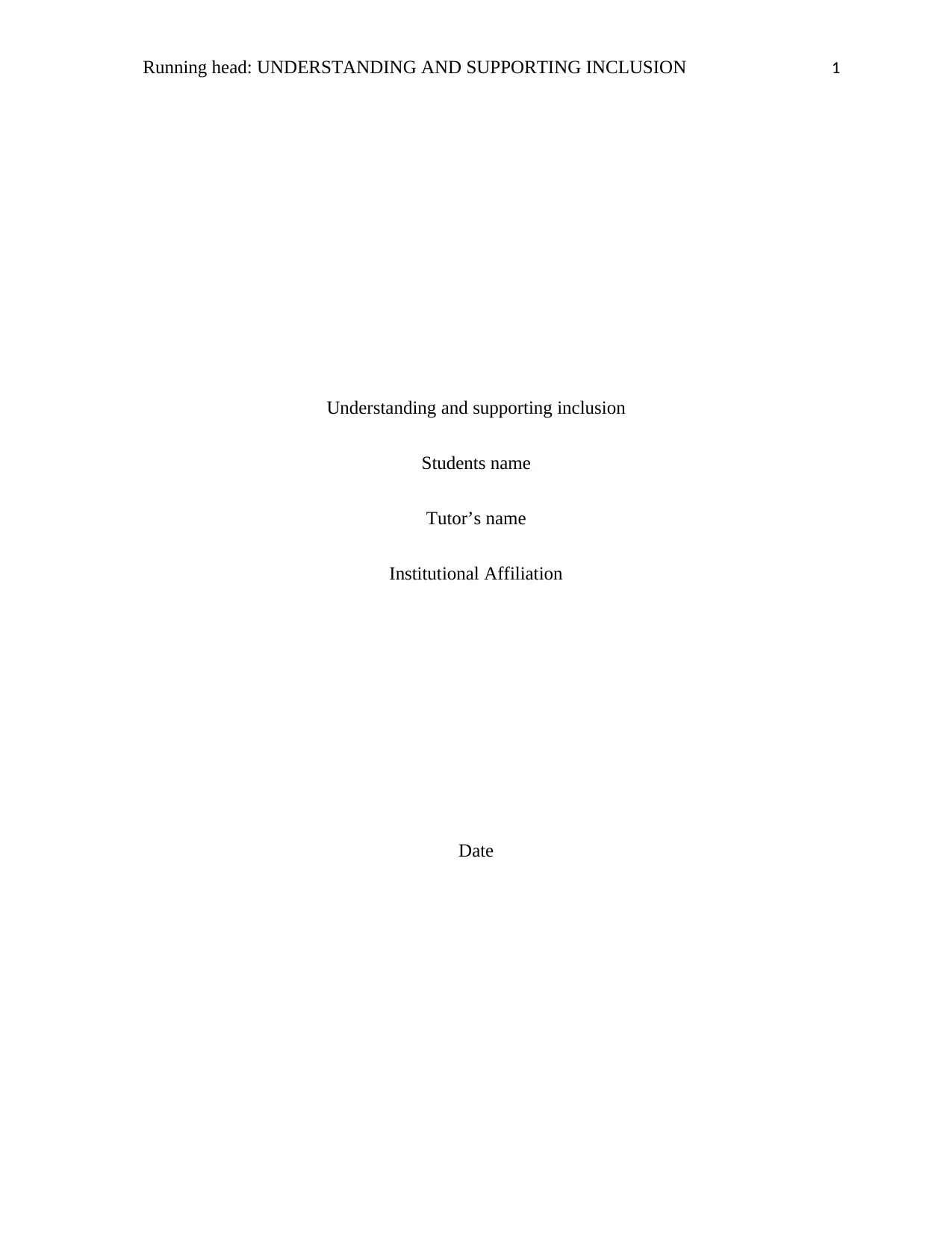
Running head: UNDERSTANDING AND SUPPORTING INCLUSION 1
Understanding and supporting inclusion
Students name
Tutor’s name
Institutional Affiliation
Date
Understanding and supporting inclusion
Students name
Tutor’s name
Institutional Affiliation
Date
Paraphrase This Document
Need a fresh take? Get an instant paraphrase of this document with our AI Paraphraser
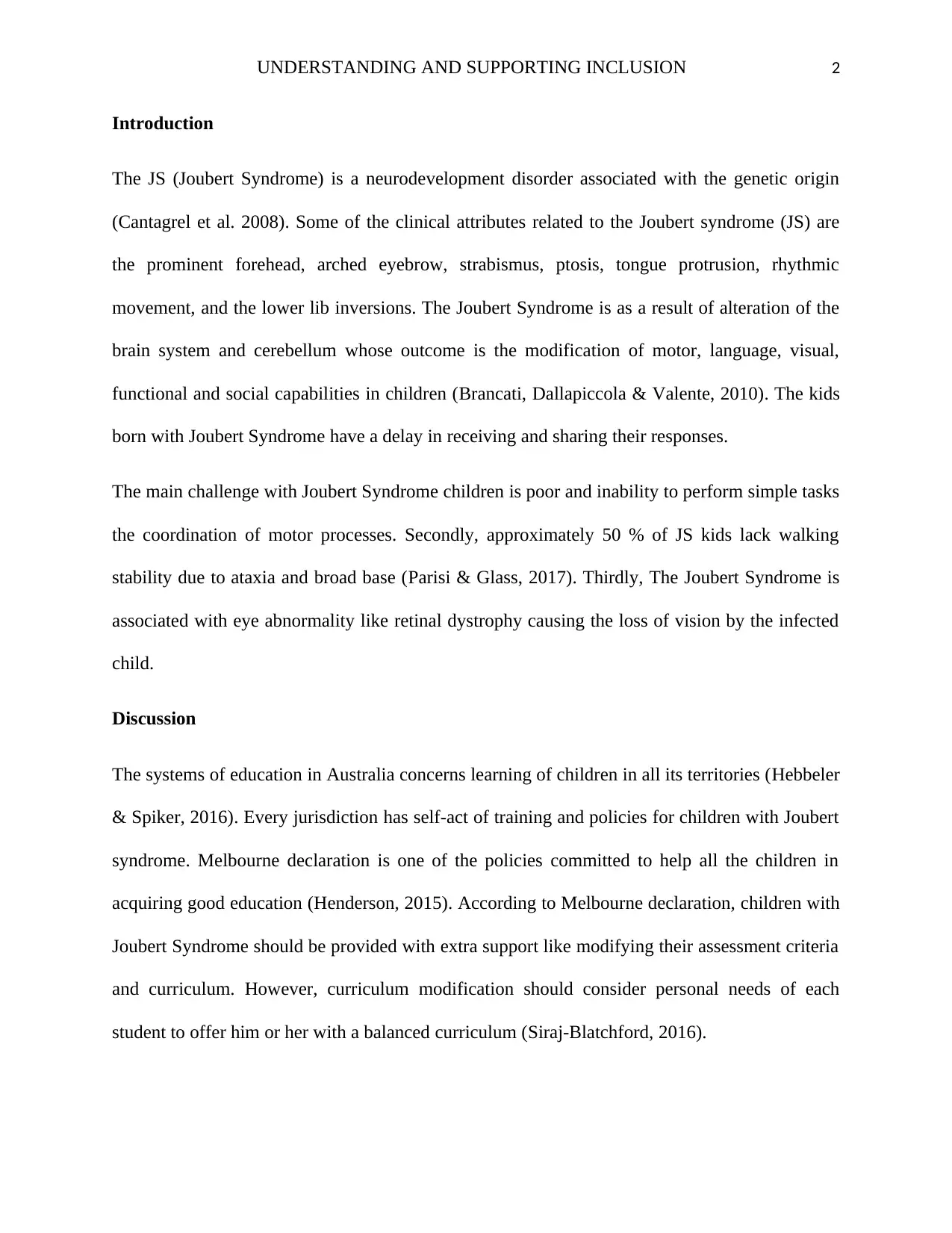
UNDERSTANDING AND SUPPORTING INCLUSION 2
Introduction
The JS (Joubert Syndrome) is a neurodevelopment disorder associated with the genetic origin
(Cantagrel et al. 2008). Some of the clinical attributes related to the Joubert syndrome (JS) are
the prominent forehead, arched eyebrow, strabismus, ptosis, tongue protrusion, rhythmic
movement, and the lower lib inversions. The Joubert Syndrome is as a result of alteration of the
brain system and cerebellum whose outcome is the modification of motor, language, visual,
functional and social capabilities in children (Brancati, Dallapiccola & Valente, 2010). The kids
born with Joubert Syndrome have a delay in receiving and sharing their responses.
The main challenge with Joubert Syndrome children is poor and inability to perform simple tasks
the coordination of motor processes. Secondly, approximately 50 % of JS kids lack walking
stability due to ataxia and broad base (Parisi & Glass, 2017). Thirdly, The Joubert Syndrome is
associated with eye abnormality like retinal dystrophy causing the loss of vision by the infected
child.
Discussion
The systems of education in Australia concerns learning of children in all its territories (Hebbeler
& Spiker, 2016). Every jurisdiction has self-act of training and policies for children with Joubert
syndrome. Melbourne declaration is one of the policies committed to help all the children in
acquiring good education (Henderson, 2015). According to Melbourne declaration, children with
Joubert Syndrome should be provided with extra support like modifying their assessment criteria
and curriculum. However, curriculum modification should consider personal needs of each
student to offer him or her with a balanced curriculum (Siraj-Blatchford, 2016).
Introduction
The JS (Joubert Syndrome) is a neurodevelopment disorder associated with the genetic origin
(Cantagrel et al. 2008). Some of the clinical attributes related to the Joubert syndrome (JS) are
the prominent forehead, arched eyebrow, strabismus, ptosis, tongue protrusion, rhythmic
movement, and the lower lib inversions. The Joubert Syndrome is as a result of alteration of the
brain system and cerebellum whose outcome is the modification of motor, language, visual,
functional and social capabilities in children (Brancati, Dallapiccola & Valente, 2010). The kids
born with Joubert Syndrome have a delay in receiving and sharing their responses.
The main challenge with Joubert Syndrome children is poor and inability to perform simple tasks
the coordination of motor processes. Secondly, approximately 50 % of JS kids lack walking
stability due to ataxia and broad base (Parisi & Glass, 2017). Thirdly, The Joubert Syndrome is
associated with eye abnormality like retinal dystrophy causing the loss of vision by the infected
child.
Discussion
The systems of education in Australia concerns learning of children in all its territories (Hebbeler
& Spiker, 2016). Every jurisdiction has self-act of training and policies for children with Joubert
syndrome. Melbourne declaration is one of the policies committed to help all the children in
acquiring good education (Henderson, 2015). According to Melbourne declaration, children with
Joubert Syndrome should be provided with extra support like modifying their assessment criteria
and curriculum. However, curriculum modification should consider personal needs of each
student to offer him or her with a balanced curriculum (Siraj-Blatchford, 2016).
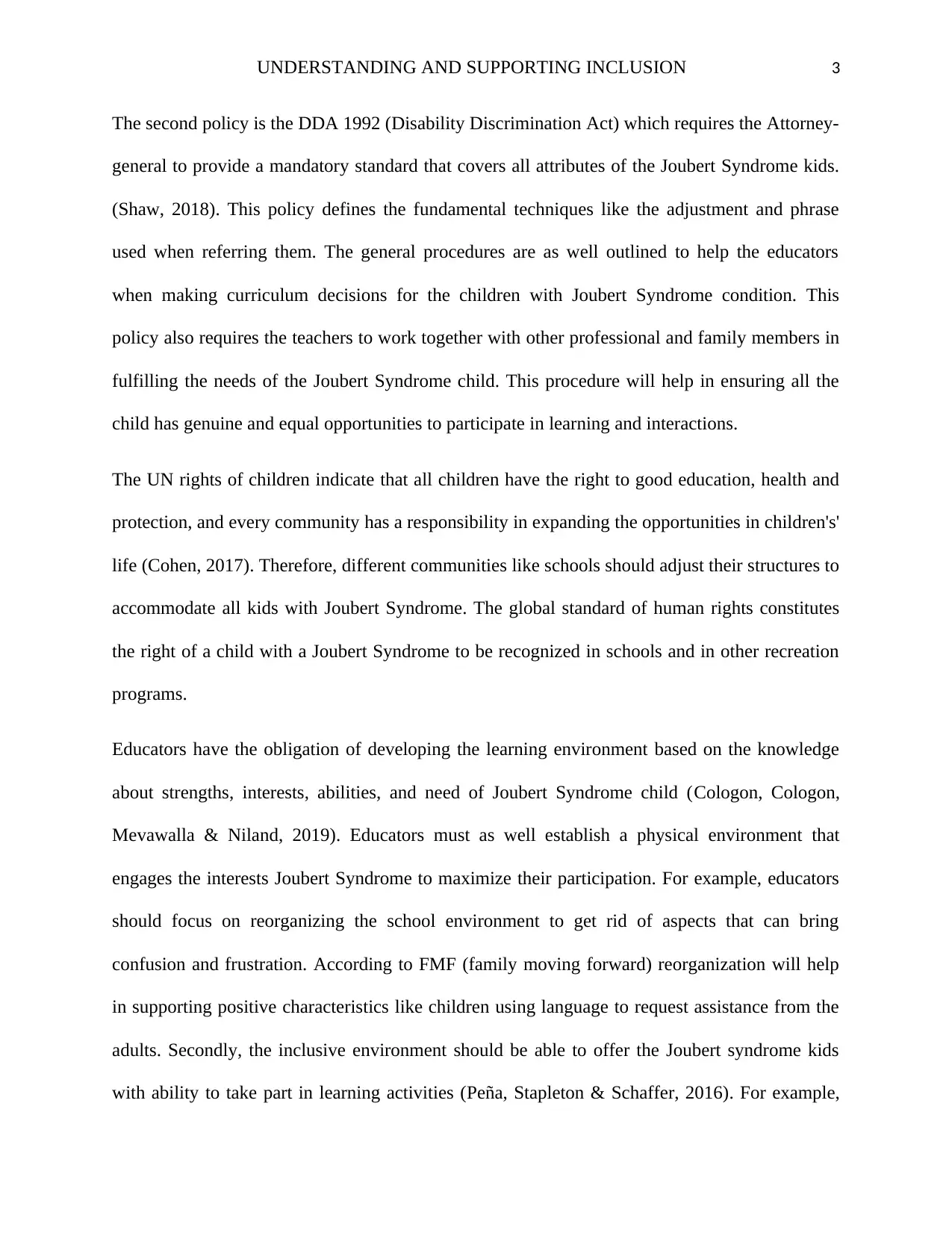
UNDERSTANDING AND SUPPORTING INCLUSION 3
The second policy is the DDA 1992 (Disability Discrimination Act) which requires the Attorney-
general to provide a mandatory standard that covers all attributes of the Joubert Syndrome kids.
(Shaw, 2018). This policy defines the fundamental techniques like the adjustment and phrase
used when referring them. The general procedures are as well outlined to help the educators
when making curriculum decisions for the children with Joubert Syndrome condition. This
policy also requires the teachers to work together with other professional and family members in
fulfilling the needs of the Joubert Syndrome child. This procedure will help in ensuring all the
child has genuine and equal opportunities to participate in learning and interactions.
The UN rights of children indicate that all children have the right to good education, health and
protection, and every community has a responsibility in expanding the opportunities in children's'
life (Cohen, 2017). Therefore, different communities like schools should adjust their structures to
accommodate all kids with Joubert Syndrome. The global standard of human rights constitutes
the right of a child with a Joubert Syndrome to be recognized in schools and in other recreation
programs.
Educators have the obligation of developing the learning environment based on the knowledge
about strengths, interests, abilities, and need of Joubert Syndrome child (Cologon, Cologon,
Mevawalla & Niland, 2019). Educators must as well establish a physical environment that
engages the interests Joubert Syndrome to maximize their participation. For example, educators
should focus on reorganizing the school environment to get rid of aspects that can bring
confusion and frustration. According to FMF (family moving forward) reorganization will help
in supporting positive characteristics like children using language to request assistance from the
adults. Secondly, the inclusive environment should be able to offer the Joubert syndrome kids
with ability to take part in learning activities (Peña, Stapleton & Schaffer, 2016). For example,
The second policy is the DDA 1992 (Disability Discrimination Act) which requires the Attorney-
general to provide a mandatory standard that covers all attributes of the Joubert Syndrome kids.
(Shaw, 2018). This policy defines the fundamental techniques like the adjustment and phrase
used when referring them. The general procedures are as well outlined to help the educators
when making curriculum decisions for the children with Joubert Syndrome condition. This
policy also requires the teachers to work together with other professional and family members in
fulfilling the needs of the Joubert Syndrome child. This procedure will help in ensuring all the
child has genuine and equal opportunities to participate in learning and interactions.
The UN rights of children indicate that all children have the right to good education, health and
protection, and every community has a responsibility in expanding the opportunities in children's'
life (Cohen, 2017). Therefore, different communities like schools should adjust their structures to
accommodate all kids with Joubert Syndrome. The global standard of human rights constitutes
the right of a child with a Joubert Syndrome to be recognized in schools and in other recreation
programs.
Educators have the obligation of developing the learning environment based on the knowledge
about strengths, interests, abilities, and need of Joubert Syndrome child (Cologon, Cologon,
Mevawalla & Niland, 2019). Educators must as well establish a physical environment that
engages the interests Joubert Syndrome to maximize their participation. For example, educators
should focus on reorganizing the school environment to get rid of aspects that can bring
confusion and frustration. According to FMF (family moving forward) reorganization will help
in supporting positive characteristics like children using language to request assistance from the
adults. Secondly, the inclusive environment should be able to offer the Joubert syndrome kids
with ability to take part in learning activities (Peña, Stapleton & Schaffer, 2016). For example,
⊘ This is a preview!⊘
Do you want full access?
Subscribe today to unlock all pages.

Trusted by 1+ million students worldwide
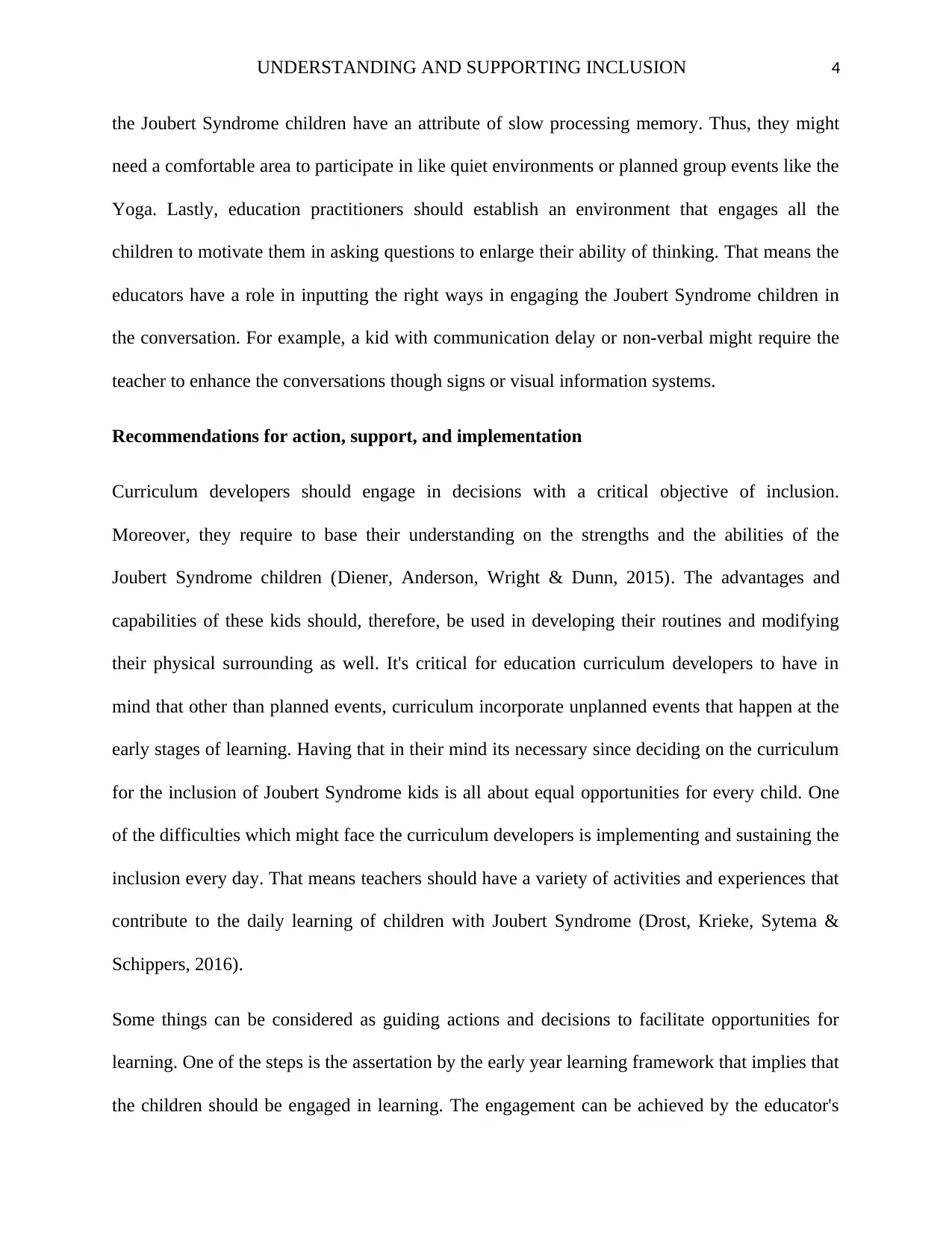
UNDERSTANDING AND SUPPORTING INCLUSION 4
the Joubert Syndrome children have an attribute of slow processing memory. Thus, they might
need a comfortable area to participate in like quiet environments or planned group events like the
Yoga. Lastly, education practitioners should establish an environment that engages all the
children to motivate them in asking questions to enlarge their ability of thinking. That means the
educators have a role in inputting the right ways in engaging the Joubert Syndrome children in
the conversation. For example, a kid with communication delay or non-verbal might require the
teacher to enhance the conversations though signs or visual information systems.
Recommendations for action, support, and implementation
Curriculum developers should engage in decisions with a critical objective of inclusion.
Moreover, they require to base their understanding on the strengths and the abilities of the
Joubert Syndrome children (Diener, Anderson, Wright & Dunn, 2015). The advantages and
capabilities of these kids should, therefore, be used in developing their routines and modifying
their physical surrounding as well. It's critical for education curriculum developers to have in
mind that other than planned events, curriculum incorporate unplanned events that happen at the
early stages of learning. Having that in their mind its necessary since deciding on the curriculum
for the inclusion of Joubert Syndrome kids is all about equal opportunities for every child. One
of the difficulties which might face the curriculum developers is implementing and sustaining the
inclusion every day. That means teachers should have a variety of activities and experiences that
contribute to the daily learning of children with Joubert Syndrome (Drost, Krieke, Sytema &
Schippers, 2016).
Some things can be considered as guiding actions and decisions to facilitate opportunities for
learning. One of the steps is the assertation by the early year learning framework that implies that
the children should be engaged in learning. The engagement can be achieved by the educator's
the Joubert Syndrome children have an attribute of slow processing memory. Thus, they might
need a comfortable area to participate in like quiet environments or planned group events like the
Yoga. Lastly, education practitioners should establish an environment that engages all the
children to motivate them in asking questions to enlarge their ability of thinking. That means the
educators have a role in inputting the right ways in engaging the Joubert Syndrome children in
the conversation. For example, a kid with communication delay or non-verbal might require the
teacher to enhance the conversations though signs or visual information systems.
Recommendations for action, support, and implementation
Curriculum developers should engage in decisions with a critical objective of inclusion.
Moreover, they require to base their understanding on the strengths and the abilities of the
Joubert Syndrome children (Diener, Anderson, Wright & Dunn, 2015). The advantages and
capabilities of these kids should, therefore, be used in developing their routines and modifying
their physical surrounding as well. It's critical for education curriculum developers to have in
mind that other than planned events, curriculum incorporate unplanned events that happen at the
early stages of learning. Having that in their mind its necessary since deciding on the curriculum
for the inclusion of Joubert Syndrome kids is all about equal opportunities for every child. One
of the difficulties which might face the curriculum developers is implementing and sustaining the
inclusion every day. That means teachers should have a variety of activities and experiences that
contribute to the daily learning of children with Joubert Syndrome (Drost, Krieke, Sytema &
Schippers, 2016).
Some things can be considered as guiding actions and decisions to facilitate opportunities for
learning. One of the steps is the assertation by the early year learning framework that implies that
the children should be engaged in learning. The engagement can be achieved by the educator's
Paraphrase This Document
Need a fresh take? Get an instant paraphrase of this document with our AI Paraphraser
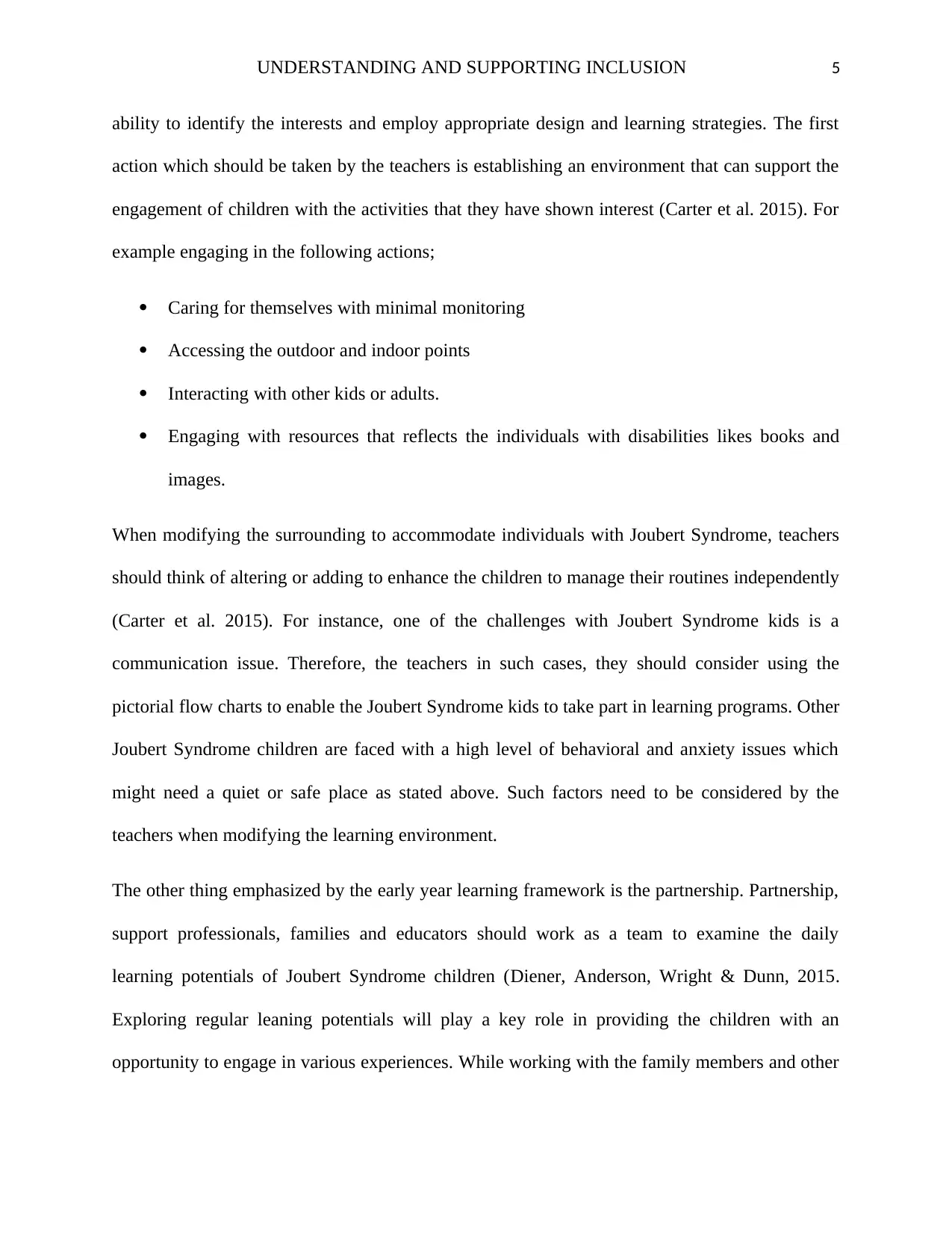
UNDERSTANDING AND SUPPORTING INCLUSION 5
ability to identify the interests and employ appropriate design and learning strategies. The first
action which should be taken by the teachers is establishing an environment that can support the
engagement of children with the activities that they have shown interest (Carter et al. 2015). For
example engaging in the following actions;
Caring for themselves with minimal monitoring
Accessing the outdoor and indoor points
Interacting with other kids or adults.
Engaging with resources that reflects the individuals with disabilities likes books and
images.
When modifying the surrounding to accommodate individuals with Joubert Syndrome, teachers
should think of altering or adding to enhance the children to manage their routines independently
(Carter et al. 2015). For instance, one of the challenges with Joubert Syndrome kids is a
communication issue. Therefore, the teachers in such cases, they should consider using the
pictorial flow charts to enable the Joubert Syndrome kids to take part in learning programs. Other
Joubert Syndrome children are faced with a high level of behavioral and anxiety issues which
might need a quiet or safe place as stated above. Such factors need to be considered by the
teachers when modifying the learning environment.
The other thing emphasized by the early year learning framework is the partnership. Partnership,
support professionals, families and educators should work as a team to examine the daily
learning potentials of Joubert Syndrome children (Diener, Anderson, Wright & Dunn, 2015.
Exploring regular leaning potentials will play a key role in providing the children with an
opportunity to engage in various experiences. While working with the family members and other
ability to identify the interests and employ appropriate design and learning strategies. The first
action which should be taken by the teachers is establishing an environment that can support the
engagement of children with the activities that they have shown interest (Carter et al. 2015). For
example engaging in the following actions;
Caring for themselves with minimal monitoring
Accessing the outdoor and indoor points
Interacting with other kids or adults.
Engaging with resources that reflects the individuals with disabilities likes books and
images.
When modifying the surrounding to accommodate individuals with Joubert Syndrome, teachers
should think of altering or adding to enhance the children to manage their routines independently
(Carter et al. 2015). For instance, one of the challenges with Joubert Syndrome kids is a
communication issue. Therefore, the teachers in such cases, they should consider using the
pictorial flow charts to enable the Joubert Syndrome kids to take part in learning programs. Other
Joubert Syndrome children are faced with a high level of behavioral and anxiety issues which
might need a quiet or safe place as stated above. Such factors need to be considered by the
teachers when modifying the learning environment.
The other thing emphasized by the early year learning framework is the partnership. Partnership,
support professionals, families and educators should work as a team to examine the daily
learning potentials of Joubert Syndrome children (Diener, Anderson, Wright & Dunn, 2015.
Exploring regular leaning potentials will play a key role in providing the children with an
opportunity to engage in various experiences. While working with the family members and other
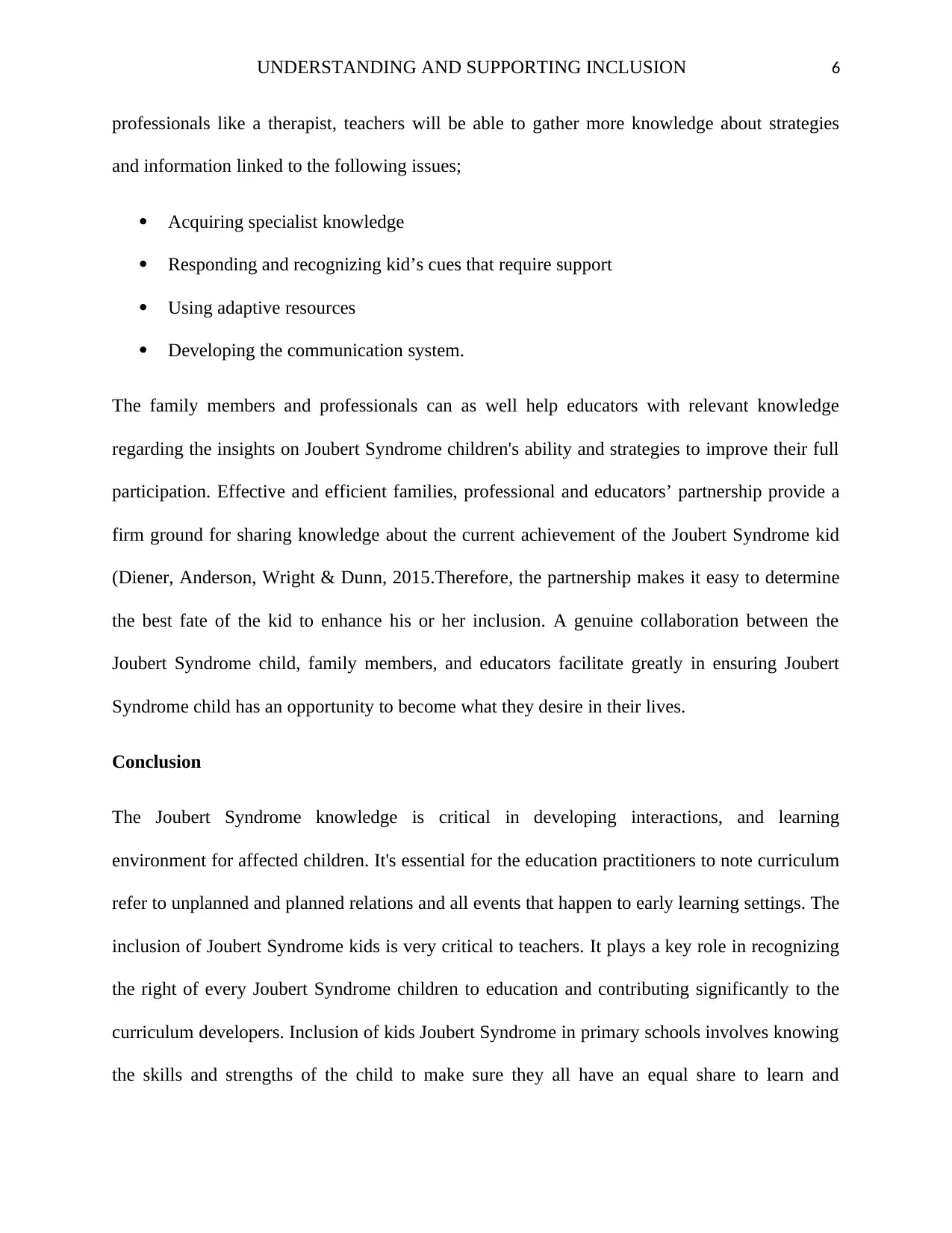
UNDERSTANDING AND SUPPORTING INCLUSION 6
professionals like a therapist, teachers will be able to gather more knowledge about strategies
and information linked to the following issues;
Acquiring specialist knowledge
Responding and recognizing kid’s cues that require support
Using adaptive resources
Developing the communication system.
The family members and professionals can as well help educators with relevant knowledge
regarding the insights on Joubert Syndrome children's ability and strategies to improve their full
participation. Effective and efficient families, professional and educators’ partnership provide a
firm ground for sharing knowledge about the current achievement of the Joubert Syndrome kid
(Diener, Anderson, Wright & Dunn, 2015.Therefore, the partnership makes it easy to determine
the best fate of the kid to enhance his or her inclusion. A genuine collaboration between the
Joubert Syndrome child, family members, and educators facilitate greatly in ensuring Joubert
Syndrome child has an opportunity to become what they desire in their lives.
Conclusion
The Joubert Syndrome knowledge is critical in developing interactions, and learning
environment for affected children. It's essential for the education practitioners to note curriculum
refer to unplanned and planned relations and all events that happen to early learning settings. The
inclusion of Joubert Syndrome kids is very critical to teachers. It plays a key role in recognizing
the right of every Joubert Syndrome children to education and contributing significantly to the
curriculum developers. Inclusion of kids Joubert Syndrome in primary schools involves knowing
the skills and strengths of the child to make sure they all have an equal share to learn and
professionals like a therapist, teachers will be able to gather more knowledge about strategies
and information linked to the following issues;
Acquiring specialist knowledge
Responding and recognizing kid’s cues that require support
Using adaptive resources
Developing the communication system.
The family members and professionals can as well help educators with relevant knowledge
regarding the insights on Joubert Syndrome children's ability and strategies to improve their full
participation. Effective and efficient families, professional and educators’ partnership provide a
firm ground for sharing knowledge about the current achievement of the Joubert Syndrome kid
(Diener, Anderson, Wright & Dunn, 2015.Therefore, the partnership makes it easy to determine
the best fate of the kid to enhance his or her inclusion. A genuine collaboration between the
Joubert Syndrome child, family members, and educators facilitate greatly in ensuring Joubert
Syndrome child has an opportunity to become what they desire in their lives.
Conclusion
The Joubert Syndrome knowledge is critical in developing interactions, and learning
environment for affected children. It's essential for the education practitioners to note curriculum
refer to unplanned and planned relations and all events that happen to early learning settings. The
inclusion of Joubert Syndrome kids is very critical to teachers. It plays a key role in recognizing
the right of every Joubert Syndrome children to education and contributing significantly to the
curriculum developers. Inclusion of kids Joubert Syndrome in primary schools involves knowing
the skills and strengths of the child to make sure they all have an equal share to learn and
⊘ This is a preview!⊘
Do you want full access?
Subscribe today to unlock all pages.

Trusted by 1+ million students worldwide
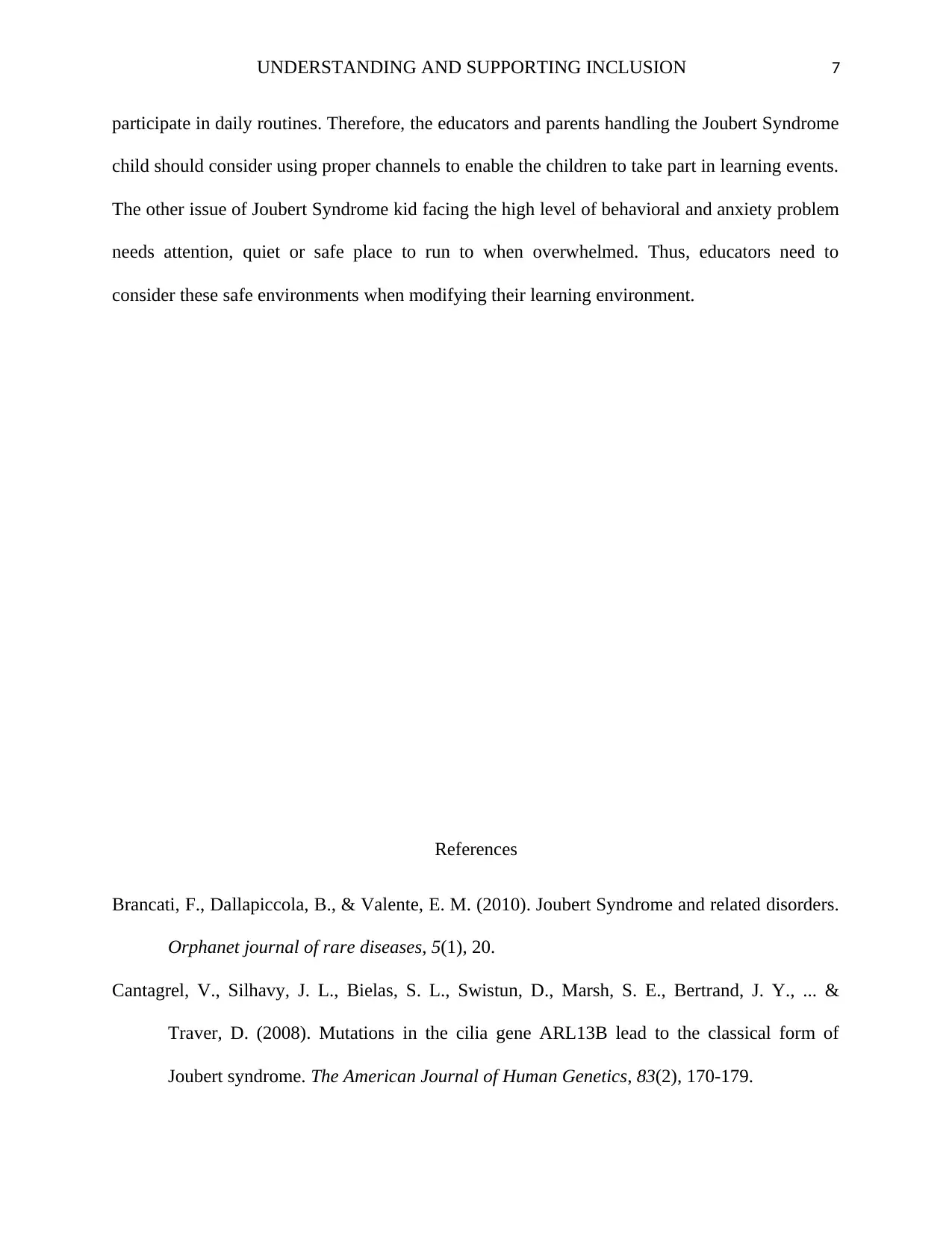
UNDERSTANDING AND SUPPORTING INCLUSION 7
participate in daily routines. Therefore, the educators and parents handling the Joubert Syndrome
child should consider using proper channels to enable the children to take part in learning events.
The other issue of Joubert Syndrome kid facing the high level of behavioral and anxiety problem
needs attention, quiet or safe place to run to when overwhelmed. Thus, educators need to
consider these safe environments when modifying their learning environment.
References
Brancati, F., Dallapiccola, B., & Valente, E. M. (2010). Joubert Syndrome and related disorders.
Orphanet journal of rare diseases, 5(1), 20.
Cantagrel, V., Silhavy, J. L., Bielas, S. L., Swistun, D., Marsh, S. E., Bertrand, J. Y., ... &
Traver, D. (2008). Mutations in the cilia gene ARL13B lead to the classical form of
Joubert syndrome. The American Journal of Human Genetics, 83(2), 170-179.
participate in daily routines. Therefore, the educators and parents handling the Joubert Syndrome
child should consider using proper channels to enable the children to take part in learning events.
The other issue of Joubert Syndrome kid facing the high level of behavioral and anxiety problem
needs attention, quiet or safe place to run to when overwhelmed. Thus, educators need to
consider these safe environments when modifying their learning environment.
References
Brancati, F., Dallapiccola, B., & Valente, E. M. (2010). Joubert Syndrome and related disorders.
Orphanet journal of rare diseases, 5(1), 20.
Cantagrel, V., Silhavy, J. L., Bielas, S. L., Swistun, D., Marsh, S. E., Bertrand, J. Y., ... &
Traver, D. (2008). Mutations in the cilia gene ARL13B lead to the classical form of
Joubert syndrome. The American Journal of Human Genetics, 83(2), 170-179.
Paraphrase This Document
Need a fresh take? Get an instant paraphrase of this document with our AI Paraphraser
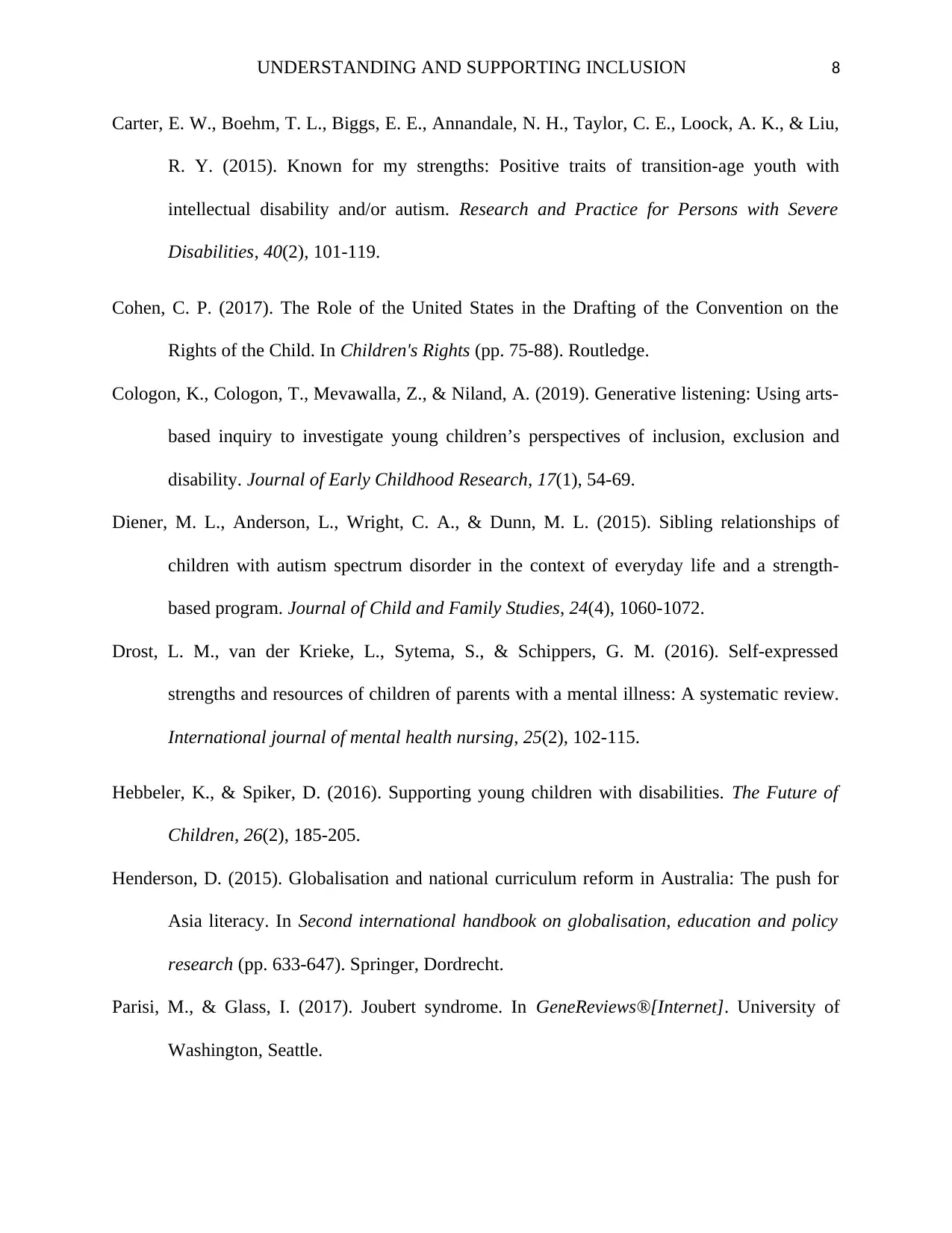
UNDERSTANDING AND SUPPORTING INCLUSION 8
Carter, E. W., Boehm, T. L., Biggs, E. E., Annandale, N. H., Taylor, C. E., Loock, A. K., & Liu,
R. Y. (2015). Known for my strengths: Positive traits of transition-age youth with
intellectual disability and/or autism. Research and Practice for Persons with Severe
Disabilities, 40(2), 101-119.
Cohen, C. P. (2017). The Role of the United States in the Drafting of the Convention on the
Rights of the Child. In Children's Rights (pp. 75-88). Routledge.
Cologon, K., Cologon, T., Mevawalla, Z., & Niland, A. (2019). Generative listening: Using arts-
based inquiry to investigate young children’s perspectives of inclusion, exclusion and
disability. Journal of Early Childhood Research, 17(1), 54-69.
Diener, M. L., Anderson, L., Wright, C. A., & Dunn, M. L. (2015). Sibling relationships of
children with autism spectrum disorder in the context of everyday life and a strength-
based program. Journal of Child and Family Studies, 24(4), 1060-1072.
Drost, L. M., van der Krieke, L., Sytema, S., & Schippers, G. M. (2016). Self‐expressed
strengths and resources of children of parents with a mental illness: A systematic review.
International journal of mental health nursing, 25(2), 102-115.
Hebbeler, K., & Spiker, D. (2016). Supporting young children with disabilities. The Future of
Children, 26(2), 185-205.
Henderson, D. (2015). Globalisation and national curriculum reform in Australia: The push for
Asia literacy. In Second international handbook on globalisation, education and policy
research (pp. 633-647). Springer, Dordrecht.
Parisi, M., & Glass, I. (2017). Joubert syndrome. In GeneReviews®[Internet]. University of
Washington, Seattle.
Carter, E. W., Boehm, T. L., Biggs, E. E., Annandale, N. H., Taylor, C. E., Loock, A. K., & Liu,
R. Y. (2015). Known for my strengths: Positive traits of transition-age youth with
intellectual disability and/or autism. Research and Practice for Persons with Severe
Disabilities, 40(2), 101-119.
Cohen, C. P. (2017). The Role of the United States in the Drafting of the Convention on the
Rights of the Child. In Children's Rights (pp. 75-88). Routledge.
Cologon, K., Cologon, T., Mevawalla, Z., & Niland, A. (2019). Generative listening: Using arts-
based inquiry to investigate young children’s perspectives of inclusion, exclusion and
disability. Journal of Early Childhood Research, 17(1), 54-69.
Diener, M. L., Anderson, L., Wright, C. A., & Dunn, M. L. (2015). Sibling relationships of
children with autism spectrum disorder in the context of everyday life and a strength-
based program. Journal of Child and Family Studies, 24(4), 1060-1072.
Drost, L. M., van der Krieke, L., Sytema, S., & Schippers, G. M. (2016). Self‐expressed
strengths and resources of children of parents with a mental illness: A systematic review.
International journal of mental health nursing, 25(2), 102-115.
Hebbeler, K., & Spiker, D. (2016). Supporting young children with disabilities. The Future of
Children, 26(2), 185-205.
Henderson, D. (2015). Globalisation and national curriculum reform in Australia: The push for
Asia literacy. In Second international handbook on globalisation, education and policy
research (pp. 633-647). Springer, Dordrecht.
Parisi, M., & Glass, I. (2017). Joubert syndrome. In GeneReviews®[Internet]. University of
Washington, Seattle.
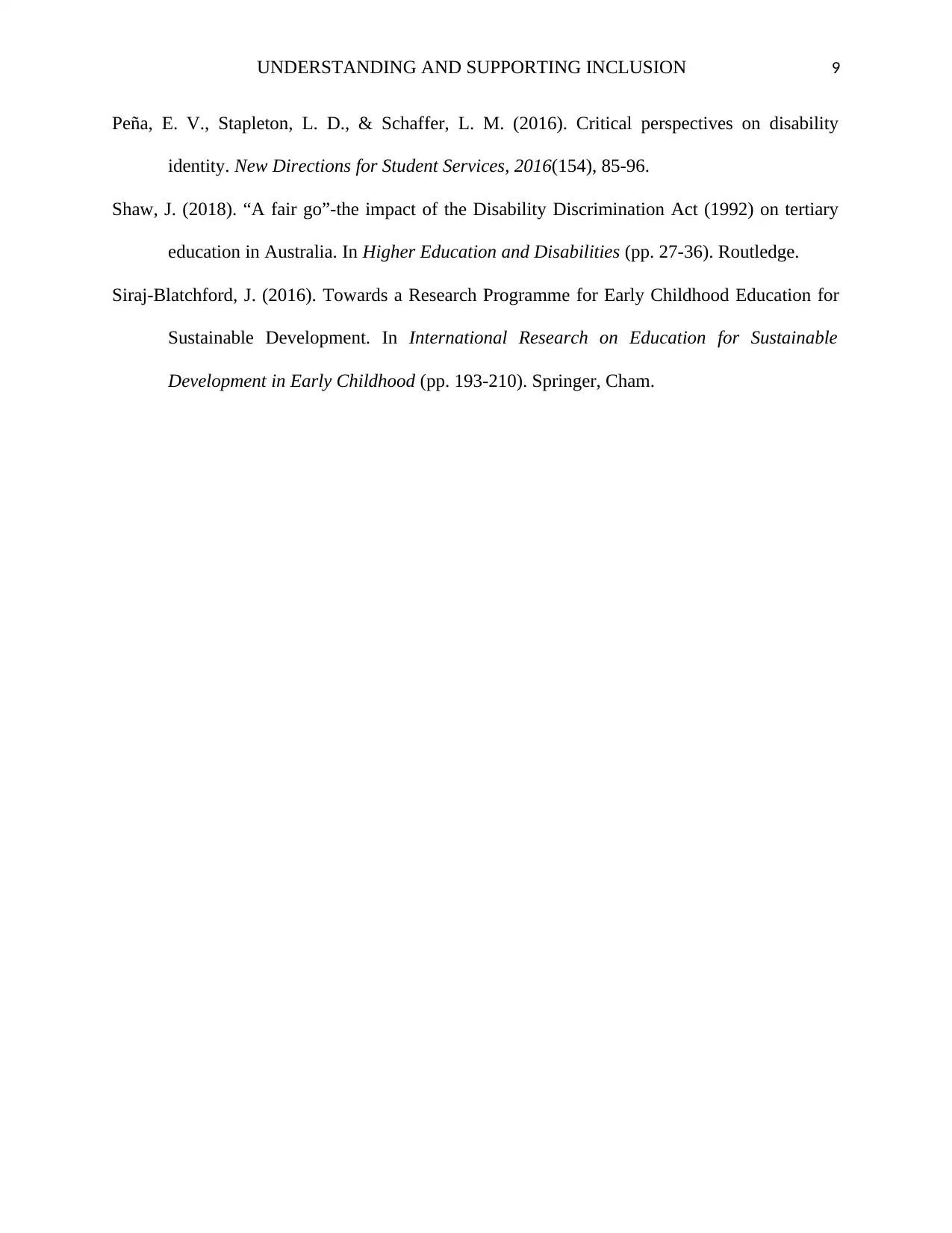
UNDERSTANDING AND SUPPORTING INCLUSION 9
Peña, E. V., Stapleton, L. D., & Schaffer, L. M. (2016). Critical perspectives on disability
identity. New Directions for Student Services, 2016(154), 85-96.
Shaw, J. (2018). “A fair go”-the impact of the Disability Discrimination Act (1992) on tertiary
education in Australia. In Higher Education and Disabilities (pp. 27-36). Routledge.
Siraj-Blatchford, J. (2016). Towards a Research Programme for Early Childhood Education for
Sustainable Development. In International Research on Education for Sustainable
Development in Early Childhood (pp. 193-210). Springer, Cham.
Peña, E. V., Stapleton, L. D., & Schaffer, L. M. (2016). Critical perspectives on disability
identity. New Directions for Student Services, 2016(154), 85-96.
Shaw, J. (2018). “A fair go”-the impact of the Disability Discrimination Act (1992) on tertiary
education in Australia. In Higher Education and Disabilities (pp. 27-36). Routledge.
Siraj-Blatchford, J. (2016). Towards a Research Programme for Early Childhood Education for
Sustainable Development. In International Research on Education for Sustainable
Development in Early Childhood (pp. 193-210). Springer, Cham.
⊘ This is a preview!⊘
Do you want full access?
Subscribe today to unlock all pages.

Trusted by 1+ million students worldwide
1 out of 9
Related Documents
Your All-in-One AI-Powered Toolkit for Academic Success.
+13062052269
info@desklib.com
Available 24*7 on WhatsApp / Email
![[object Object]](/_next/static/media/star-bottom.7253800d.svg)
Unlock your academic potential
Copyright © 2020–2025 A2Z Services. All Rights Reserved. Developed and managed by ZUCOL.





